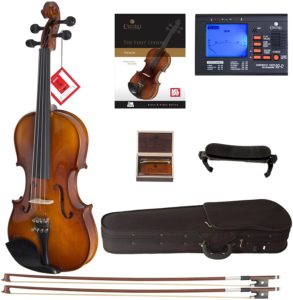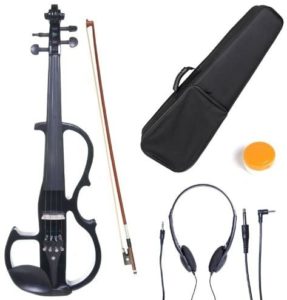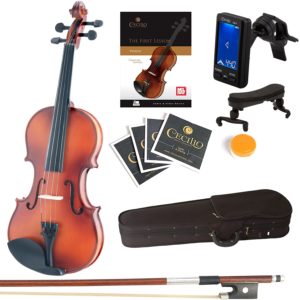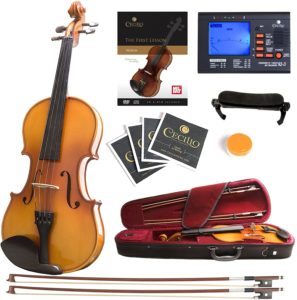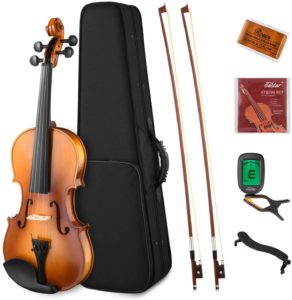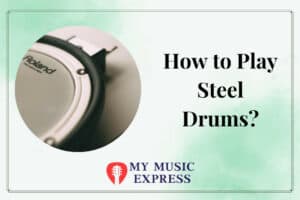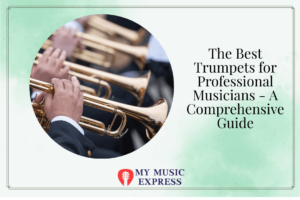There might be different types of musical instruments and hundreds of music styles, but a violin is a unanimous love for many. Many instruments come and go, but a violin is always a delight. The best violins can enlighten moods, improve mental health, and a lot more. We’ll get to the core of everything as we progress.
Why a Violin among all the Other Instruments?
Well, the reason for the violin being so unique among the others is because of everything matters in playing it. The pressure at which we press the strings with the left hand’s fingers to the stroke that we give with the bow – everything is crucial for a violin. While touching the strings delicately with the fingertips gives a clear and resonant tone, touching them with flat fingers results in a bland tone. Too much pressure leaves the tone missing the resonance.
The way the right-hand moves decides the tone of the violin. We already know that the bow is responsible for all the beautiful tunes, right! At what angle is the bow moving? How much pressure are we putting on it for the tunes? How do we change factors like angle, pressure, rotation, and others? The answers to all these questions give us an experience worth losing everything!
A light movement of the angle leaves a menacing tone. We wouldn’t want to end up having a bad experience, would we? Right hand at a perfect angle, bow with perfect pressure and rotations, and exact stress on the strings using the left hand’s fingertips combine to form a fantastic tune each time we play the violin. For all these to fall in place, how much focus and concentration do we need?
Violin and Health-related Benefits
Knowing how to play a musical instrument perfectly and confidently is so relaxing. If there’s any musical instrument that can be picked up and played instantly, what will you choose? The chances are more for a violin to be among the top priority than all the other instruments.
But there is a catch here. Though there is a divine aura, soulful, and romantic mystique around a violin, most people feel that it is either expensive or hard to master this most loved instrument. But the lifetime benefits from this piece of divinity is way beyond our imagination.
When we talk about what the best violins can do to our body, we’d probably be amazed! Be it a kid, adult, or an old man, each of us has a lot to gain from a violin. Under the right guidance and by using the right tools, there is so much we can grab from a violin. Here are the health benefits of a violin for different age groups:
- Benefits from a Violin for Children
Kids would be more fascinated to play the violin and if your kids are, encourage them in every possible way, for the benefits from it are phenomenal. Physical, psychological, and emotional benefits from any musical instruments are always exceptional, but a violin leaves us astounded. It adds up to the social benefits as well. Let’s check all of them in detail.
Memory – Many kinds of research suggest that learning a musical instrument, including the violin, has a lot of positive influence on people, especially kids. Researchers also found that this impact extends to attentive skills as well.
Sensory Skills – High-level and long-term musical training has a lot of impact on people’s sensory abilities. Research suggests that musicians have more incredible abilities to decode sensory information from touch, hearing, and vision.
Mental Functionalities – Skills like reading, speaking, language processing, and other brain functions improve so much with musical training. Studies related to “enhanced brain development” clearly suggest that playing the violin can help cure a child’s psychological problems.
Social Life – Wonder how the violin can improve social skills? Well, the repeated practice leaves children more self-disciplined and confident. Self-awareness, self-reliance, self-esteem, etc., are fruits for kids from a violin, leaving them well-behaving. Confidence and discipline can do anything, right?
- Benefits from a Violin for Teens
Teens indulge in a variety of extra-curricular activities to boost their skills and improve their applications. So, here are some exclusive benefits for teens from a violin.
Physical – Let’s start with the physical benefits first. Healthy upper body, improved posture, and enhanced motor skills are some benefits of a violin. Through proper body positioning, while playing the violin, the body’s physical exertion reduces as well.
Emotional – Teens find it challenging to express their emotions in a constructive way. Playing the violin improves emotional expressions.
Sense of Belongingness – If you’re a part of an orchestra or a band, you’d understand the importance of group coordination, dress code, and attention better. When we indulge with a group of people, the chances of feeling lonely are a little less. This social belonging relieves the angst and pressures a teenager faces.
Admissions – Well, when you’re standing ahead of others with a unique skill, chances of getting into the right college are reasonable. Music education and proficiency is always a better overall skill.
- Benefits from a Violin for Adults
There is no age limit for learning, right? Age is never an obstacle for music. Be it vocal or instrumental, music always welcomes us with open arms irrespective of age. Here’s how a violin benefits an adult.
Posture Correction – This is a common yet severe problem most adults face due to various reasons like lifestyle. The sedentary life leaves adults with a terrible posture leading to various critical concerns. Proper positioning is a must to play the violin flawlessly. This positioning corrects most posture-related issues.
Stress – Many kinds of research suggest that the violin is an excellent stress-buster. Depression, loneliness, anxiety, and most stress-related issues vanish quickly while we play the violin peacefully.
The overall benefits, including psychological, physical, and emotional, are absolutely worth the time we invest in learning and playing the violin. With proper equipment at the right time, one can gain so much from this instrument. So, let’s understand the complete analogy of a violin and know the instrument better and decide the best violin to buy accordingly.
The analogy of a Violin
A violin has the potential to fill the world of an entire person. How much ever we feel that we know about a violin, there is still a lot more from it. Let’s not waste any time and know all the crucial details related to the violin to better understand the instrument.
Violin’s Design Description
A soundboard is familiar to any stringed instrument. But what is it, and why do the string instruments need it? The soundboard is some kind of a bridge to the strings of the stringed instruments. Also known as the belly, top table, or a table, the soundboard is the surface that the strings vibrate against. The uniqueness of the violin comes from the arched back and top and the stunning hour glassed-shape.
Other parts that comprise the violin are – neck, bridge, four strings, two end blocks, maple ribs, and an optional chinrest whose position is customizable accordingly. Usually, the violins use animal glues instead of the usual white glue we use for everyday purposes. The intriguing fact about a violin is that the tunes from the instrument entirely depend on its shape, the type of wood used, the varnished used to coat the outer surface, and the thickness of the top and back.
Another interesting thing to note here is that the tune from this spectacular stringed instrument also depends on the skill a luthier poses to construct the violin. Wonder, who is a luthier? He is the person who makes stringed instruments like the guitar and violin. Ever thought why an old violin is preferred over the latest build? The violin varnish and the wood tend to improve with time, making them the best choice for creating fantastic tunes.
Parts of a Violin
Each part of a violin collaboratively contributes to the divine tunes from it. There is a tremendous skill and thought involved in making a violin. It is so fascinating to be able to understand the contribution of each part of the violin. Let’s start at the top and proceed further.
- Purfling
This is a narrow edge laid on to the top of a violin and sometimes at the bottom. The main motto behind including the purfling to a violin or any stringed instrument ensures protection from the cracks originating from the edges. Purfling also enhances the flexibility of the top part of the rib. Generally, cheaper violins skip the purfling and instead use paints for the same purpose of protection against cracks.
- Scroll and Pegbox
Scroll comes at the top of the violin in the construction, and the pegbox follows the scroll. Pegbox comes with four different screw-type mechanisms called pegs dedicated to a violin’s four strings uniquely. Rotating or adjusting these results in proper string positioning for different kinds of music. This can also be treated as tightening the strings to the required pressure. Pegs require timely replacement to serve better.
The violin strings have a colored string wrapping at both ends, i.e., at the start of the neck and around the pegs, so that it would be easy to identify them. Pegs are generally made of rosewood, ebony, boxwood, or others based on various factors like minimizing the wear and price. Initial times with wooden pegs weren’t that good as they used to be larger in size and a bit heavier. Modernization led to the development of internally geared pegs, avoiding the need for replacement.
Scroll, on the other hand, is an added decoration to the stringed instruments, especially the violin family. The scroll is a carved rolled-up spiral and one of the best ways to test a luthier’s skill in making the best violins. The excellence of a violin can be understood by the carving of the scroll. The scrolls are believed to replicate the logarithmic spirals in the design.
- Neck
The neck forms the base for the fingerboard for some stringed instruments like a violin and a guitar. We’ll understand what a fingerboard is in a little while but, for now, let’s focus on the neck part. It is a projection from the violin’s main body and acts as a place where our fingers can be placed on the violin’s strings to control different pitches. We usually find the neck part in stringed instruments like guitars, the entire violin family, lutes, etc. The shapes of the neck and fingerboard decide the ease at which one can play the violin.
In general, a violin’s neck is made out of flamed figure maple wood that fits in with the back and ribs. Thinking of what a flamed figure is? The figure, in simple terms, is a bit different from the regular wood surface. The figure is stripped and is not a plain surface. In modern mechanics, a luthier uses ebony to construct the fingerboard and attaches it to the neck.
Ebony is a strong, resistive, and durable material in all aspects. To make it easier to play the violin, a luthier avoids varnishing the neck and instead polishes and seals it. This step ensures rapidity in shifting the playing positions of a violin.
- Fingerboard
This is the component that differentiates stringed instruments from non-stringed ones. Fingerboard, already known as the fretboard, is a long thin strip of wood or metal. Usually, the fretboard is fixed or laminated onto the neck part of the stringed instrument. Fingerboards play a crucial role in delivering the enchanting tunes from the stringed instruments.
We find the four strings of the violin running over the fingerboard between its bridge and the neck. A violinist controls the instrument’s pitch and tune by pressing the strings against the fingerboard with the required pressure. This changes the pitch and vibrating length, thereby delivering the exact tune.
The process in which musicians position their hands and fingers on the stringed instruments is called ‘stopping.’ Based on the type of instrument, people either press the strings against the fingerboard or pluck them. In a violin, the fingerboard acts as a supportive base for stopping the strings and controlling the desired tunes.
- Bridge
The bridge of any stringed instrument, including the violin, acts as an anchor point for the strings at the lower end. The strings’ vibration transfers to the violin’s body through the bridge. The curve at the top of the bridge holds the strings at the required length for proper tuning. Raising the strings above the fingerboard allows us to play each string separately using the bow.
The bridge and flex have a noticeable impact on the sound quality as they combinedly act as a mechanical acoustic filter. An interesting thing about the bridge is, when we tune the pegs to adjust the strings, we are actually adjusting the bridge’s position but not the strings. The bridge leans towards the fingerboard when we try to tighten the strings. Professionals know how to center and straighten a violin’s bridge accordingly.
- Tailpiece
A violin’s tailpiece comes from metal, carbon, wood, or plastic. A nylon monofilament rides over a block of ebony on the top end and goes around the endpin in the present days. We can find this pin in a hole near the bottom block of the instrument. The endpin is made with the same material as that of the other parts to balance the design. The tailpiece finishes the strings’ positioning by anchoring their opposite end using the tailgut.
Apart from the endpin, the strings’ fine tuners are also fixed to the tailpiece in some cases. A violin requires fine tuners if a violinist finds it challenging to tune the strings with the pegs alone. Usually, the E string has a fine tuner. Beginners and some professionals use fine tuners for all the four strings to minimize the possible disturbance of the violin’s sound effects.
- Bass Bar and Soundpost
A soundpost is a cylindrical rod placed inside a stringed instrument. Present under the bridge’s treble end, the soundpost holds to its position with the help of friction. It acts as structural support to stringed instruments and transfers sounds between top and backplates. Apart from this, soundpost also alters the tones by modifying the vibration modes of the plates. No glue or adhesive holds the soundpost in place, and its positioning entirely depends on string tension.
Positioning the soundpost is nothing less than excellence, for it is both art and science. The luthier’s structural sense, experience, and touch in adjusting the soundpost make all the difference in the tune. A slight movement in the soundpost’s position influences the tunes to a greater extent. In short, the loudness and quality of sound depend so much on it. Adjusting the position purely depends on the ear of the person doing it, as he fixes it based on the outcome he desires.
The bass bar runs on the opposite side of the bridge. The bass bar’s mass and shape impact the tone, but this isn’t as flexible as the soundpost. Unlike the latter, the bass bar is fixed at an angle to the center joint of the violin precisely.
- Strings
The magical tunes from the stringed instruments come from the strings. The name ‘stringed instrument’ itself speaks everything about the prominence of a string. Most people love stringed instruments above the others because, though they are hard to master, there is so much bliss from them.
A violin has four strings – G, D, E, and A. These start from the tailpiece and run towards the neck through the bridge. They end in the pegbox positioned at the top of the violin. The four tuning pegs maintain the required tension from the strings, and the bridge takes care of their position. All of these together deliver the exact tune we are looking for.
String-making requires a lot of patience and knowledge as they are made out of a sheep’s intestine. There used to be a misconception that the violin strings were made out of a cat’s intestine like the other name for a sheep’s intestine is ‘catgut.’ But this isn’t true. The intestines are first stretched and dried thoroughly. After drying, they are twisted to get the desired string. A string maker or a string making company, anyone can manufacture the strings. There are many such resources from where we can get excellent strings for all of the best violin brands.
- Evolution of Different String Types
Gut strings find the maximum usage in period and modern music. Over time, violinists who are experts in classical music use the gut strings quite often compared to other music styles. During the 19th century, people included metal windings to the gut strings to enhance low-pitch ranges. Known as Wound Strings, these prove the best to limit the usual gut strings’ flabby noise during low pitches.
Wound gut strings are not so stable as they quickly react to the heat and moisture produced between the core and winding of a particular string and between the strings. Plain gut strings, on the other hand, tend to be relatively stable and long-lasting. They are known for their excellent sound quality until the very last minute of the lifespan they hold.
Then came the Modern Strings, with either a steel core or a stranded synthetic core wounded with different metals. The steel core can either be a solid or can be stranded by using various metals. The difference between these cores is that a steel core can be of two types, as mentioned above, but the synthetic is a single variant.
These low-density cores ensure sufficient thinness of the strings so that the tune is perfect and provides the required tension to reach the proper pitch. The idea behind the string being wound with different metals is to minimize vibrations’ damping and manipulate the overtones’ strength.
- Core
A string’s core can either be a synthetic, solid metal, or a twisted steel filament. Usually, the uppermost E-string is a solid-steel one, either wounded with aluminum or just left plain. We sometimes find gold plating on the strings. Luthiers believe that this plating delays steel corrosion. Stainless steel is also used in making the string core, but it gives a slightly different tone. Nylon is a widely used and the most popular synthetic core. These are the best known for the greater lifespan and less sensitivity to external changes. The last among these is the solid core-type, and these tend to wear out quickly.
- Ball, Knot, and Price
To secure the strings’ tail ends, the gut strings are usually knotted in the tailpiece’s slot. For modern strings, a bronze ball finds its use for the same purpose as mentioned above. The E-string is an exception here as well, as it uses either a loop end or a ball. This is because the string’s fine tuners hold the string ends on to a hook.
One thing that concerns most people is pricing. The steel strings come in the least pricing among all the available ones. Gut strings are the most expensive, and the synthetic core strings follow them. Having said that, the gut strings that are entirely natural without any metal windings are very low in pricing, especially for the A and E strings.
- Lifespan
Various factors decide the lifespan of any kind of string. Perspiration and interaction with string material, playing style, frequency of usage, fingernails, etc., have a significant impact on all the strings’ longevity. As the factors mentioned above are different for each individual, strings’ lifespan is highly variable.
- Sound Quality
We very well know that the sound quality is mostly decided by the strings it uses. We can make remarkable changes and adjustments to a violin’s sound by choosing different string types. Plain gut, wound gut, steel gut, and artificial gut make the real difference in the sound output. Here’s how.
Steel and Plain Guts – These are bright and full of overtones. But we can clearly make out the difference between them and use the desired one accordingly.
Wound Gut – Violinists prefer these when the output needs to be soft and pleasant without being harsh.
Artificial Gut – For bright tones, these are a perfect choice as they are specially designed for such tones.
Country fiddle playing uses steel or metal guts, while orchestral playing uses artificial or wound gut. Plain gut fits the best for baroque styles. Generally, individual music styles require a specific type of gut for the best results. But there is no rule or force to it, and the choice is ultimately left to the person playing the instrument.
- Chin Rest
A person playing the violin should never go wrong in the positioning of the instrument. The violin must be held horizontal, i.e., parallel to the ground. To maintain that, a violinist needs to hold the instrument with his or her chin. In the beginning, violinists directly placed their chins on the instrument and held the position. But as time progressed, chinrests came to force.
A chinrest is a piece of plastic or wood attached to the violin’s tailpiece so that a violinist can have comfortable support while holding the violin. A chinrest was intended to protect the tailpiece initially and later was developed as a comforting aid. Traditional chinrests usually come from three different types of wood – Rosewood, Ebony, and Boxwood.
We generally find plastic chinrests in beginner violins as they are more comfortable than wooden ones. Quite often, people might face various problems like skin irritation, insufficient length, and sharp jaws. These could be severe if we don’t choose the appropriate chinrest. Based on different concerns, we can choose different chinrests.
At present, there are five different chinrests available to us. They are as follows
Guarneri Chinrest – This is known to be the most comfortable and named after a specific family of Luthiers from Italy. This chinrest directly attaches to the tailpiece with the cup towards the left side. In this way, it is both a support for the user and protection to the instrument.
Flesch Chinrest – It is a cup chinrest and is placed on the tailpiece in the center. This chinrest is named after Carl Flesch, a renowned Hungarian Violinist.
Morawetz Chinrest – This is mount towards the left side of the best violins. It comes with a lip at the front of the chin cup.
Kaufman Chinrest – It comes with a flattened cup and mounts towards the violin’s left.
Dresden Chinrest – This chinrest also mounts towards the left side of the best violins. Its specialty is, it has a contoured cup that correctly supports the actual human chin.
We need to check while choosing a chinrest for our violin to verify if our chin and jawbone entirely rest on the chinrest’s cup. Without this alignment, there is no use in buying the chinrest. Also, choose an appropriate height for the chinrest based on the neck’s height to avoid discomfort and other complications.
- Bow
How could we play the violin without a bow? It is impossible to do that. A violin is complete only when it is balanced by a perfect bow. Together, they deliver the eternal musical delight we are all looking for. So, let’s finish off with the best violins mechanics by understanding the bow.
In simple terms, a bow is made of horsehair ribbon attached to the frog and tip, i.e., the opposite ends. To adjust the ribbon’s stiffness as in tight or loose, there is a screw present at the frog end for this purpose. We can customize the frog end with eyes, metal rings, etc., as per our choice. The joint where the horsehair holds itself together is known as ‘mortise.’
The bow’s flat side comes from ebony, and the sealing metal ferrule holds together the shell side and the hair-spread wedge. A thumb cushion or a leather grip is present at the frog end to provide a proper grip to the violinist. This cushion acts as a protection to the bow apart from giving a firm hold to the person playing. Finishing all the above-said arrangement is a winding, present right before the leather grip, serving the same purpose as the cushion.
There is a little effect on the bow’s balance due to this winding present before the leather grip. Silk, a wire, or plastic, anything among these could be used as a winding. Now, coming to the stick part that holds everything in place. It is either made of graphite or ironwood. Using carbon for making them stick is pure craftsmanship. Fiberglass also finds its use in some kinds of bow sticks.
The best violins uses a white horse’s hair for the bow’s hair, but some cheaper variants use synthetic fiber as an alternative. Many cases force us to change the bow’s hair regularly. The violinist feels that the bow lost the grip, some of the hair is broken or damaged, or if the ‘bow bug’ (a special kind of insects that eat and spoil bow’s hair and other similar materials) damages the hair – these could possibly result in changing the hair.
For a bow to function correctly and for the violin to produce tunes when we rub the bow against the strings, we need to rub the bow’s hair with rosin. A lot of new terms, right? Don’t worry. Rosin is a form of raisin extracted from various plants. This semi-transparent substance is available in black and yellow colors. Occasional rubbing of the bow hair with rosin grips the strings and causes the vibration or the tune.
Violin Acoustics
Acoustics has a lot to do with any musical instrument. It is the acoustical behavior of the instruments that decide the excellence of the tunes. The wood’s thickness, shape, size, and other physical characteristics decide the violin’s sound quality. In short, the acoustical behavior of the violin’s backplates and belly balance its tone and sound. To determine the violin’s quality, the luthier uses ‘Chladni Patterns’ before assembling the instrument.
In Chladni Patterns, people try to understand the nodal patterns by sprinkling some glitter or sand on the plates while vibrating them at specific frequencies. Well, there are a lot of times when I quoted nodes. What exactly are they? Nodes are the areas where there is no sound or, simply, the places of no movements. Based on the results of this pattern, the luthier then assembles the instrument.
Best Violins – Buying Guide
Having a basic idea of the instrument we are looking for is of great help. Understanding the parts and mechanics makes it easier to grab the best violins from the best violin brands available in the market.
Factors to Look for to buy the Best Violin
Here are some must-have considerations the best value violin needs to offer.
-
Type of the Violin based on construction
The fundamental thing we need to understand or decide when we think of the best violins to buy is the type of violin that suits us appropriately. Over time, there were many modifications to the violin, some being significant and the other being general. Various reasons like comfort, music style, etc., resulted in structural changes of a violin.
As a whole, different types of best violins can be studied by considering three unique factors – size, genre, and time period. Each of these three factors come with different violins on a single common ground. Here are the different violins available to us in the market:
- Different Violins in terms of size
There is a common question in most people’s minds about why we need an instrument of different sizes? Is it for different tunes, or is there another reason for it? Well, the answer to all these questions is the age of a person. Interesting, isn’t it? How can a 3-year-old lift up a violin taller than him and play?!
It isn’t impossible, but at the same time, it is difficult too. It is wise to start from the roots and get to the ends of it. So, there are different sizes for a violin based on a person’s age. But what is the difference here? A significant change happens to the size, i.e., a luthier tries to match the entire violin’s length to a person’s general arm length at a certain age.
This division has a unique name for easy identification. All the violins under the size segregation are usually known as Fractional Violins. The standard or universal size of a violin is taken as 4/4, and all the remaining ones’ fractions differ in the following way:
1/16 – This fits the best for kids between 3 to 5 years. The violin’s length ranges between 14-15 3/8 inches here.
1/10 – This is another choice for kids of the same age group as mentioned above. Here, the violin’s length lies between 15 3/8 – 17 inches.
1/8 – The top or rather the largest violin available for 3-5 years old. The arm length varies between 17 and 17 ½ inches.
1/4 – With an arm length ranging between 17 ½ and 20 inches, this fractional violin suit children of the age group 4 to 7 years.
1/2 – If you need a violin for a kid falling under the 6 to 10-year-old category, you need to look for this fraction. Here, the arm length lies in the range of 20-22 inches.
3/4 – A violin with an arm length of 22-23 ½ inches, this fraction is an ideal choice for children with ages ranging between 9 and 11 years.
4/4 – This fraction has a broad range of ages starting from 11 years and meets the adults’ requirements. The least arm’s length here is 23 ½ inches, and this value increases based on individual requirements.
There is another factor in the above list 1/64, but this is very rarely found. As mentioned earlier, the main idea behind the fractional division is to make it easier for children to learn the instrument. The violin with a 4/4 fraction is also known as the ‘full size or four-quarter’ violin. These fractions help us in choosing a kids’ violin quickly.
Tip to know the exact violin for a child
Though we’ve discussed the arm lengths for different age groups, how do we know if the violin’s length is appropriate for a particular kid? To know that, turn the violin’s backside up and rest the back on the kid’s left underarm. If your kid can easily reach the scroll in this position, that’s the violin you need to grab!
- Different Violins in terms of time
In this category, we come across different yet famous violin types fitting the best for most purposes. But before we get into the details, there’s something we need to know. Before the violin came up, different stringed instruments similar to the best violins were used. Some of them are – lira, lira de braccio or the viol, and Violetta.
Lira was from the Byzantine Empire, and it was held upright. Lira de braccio, on the other hand, was held using the chin, just as a violin. Violetta is very similar to a violin and is also held under the chin. Violetta has only three strings. These instruments sometimes fall into the violin’s category in the early stages, but there’s so much difference between them. Each of these is a unique instrument and has its charm.
Baroque Violins – The beginning of classical/ modern violin was through the Baroque violin’s invention in the 16th century. We can treat it as the forefather or the ancestor to the whole violin family. This violin is slightly thicker so that it can hold the string tensions. But the classical violins’ tension is more. Many modifications to the Baroque violins started in the 18th century to meet the current standards and expectations.
Stroh Violins – Ever heard of a violinophone or a horn-violin? These violins came to light in the 19th century from the maker – John Stroh. Now we understand why the name is Stroh Violins, right? Well, in these violins, horns replace the soundbox and serve its’ purpose. Horn gives a different timbre, and the sound is way louder than the regular violin. But these aren’t so famous due to the harsh noises and higher costs. These are a bit similar to the Romanian Horn violins but with a broad horn.
Classical Violins – I guess we’d be familiar with this when I call it the Modern or the Acoustic Violin. That’s how the classical violin is widely referred to. Starting from the 18th century, the Baroque violins underwent significant changes, and the result is the very famous and modern Classical Violin. Here, string tensions were increased to improve sound quality and range. It has a slender neck compared to the Baroque violin.
People consider the Classical Violin to be the benchmark for all the other modern-day violins. Many significant upgrades like superior-quality wood, additional accessories like chinrest, etc., came to light and made the usage more comfortable and convenient. To improve sound quality, luthiers made strings better than the existing ones. All these improvisations together enhanced the performance of a Classical Violin.
Semi-Electrical Violins – These are also acoustic violins, but they electronically amplify the output sounds. These violins are fit with a pick-up to achieve the amplification. In this case, we can hear the acoustic sound, and there is an original feel. It is easy to add pick-ups to classical violins, but we need to modify the violin accordingly if we need advancements. These modifications could be anything like a hole to insert the plug-ins. For the best of both classical and electrical touch, these best violins are a perfect choice.
Electrical Violins – In these violins, there is no sound box or f-holes. The sound comes by electronic means. As there is no soundbox, we find different electrical violins designs due to the flexibility of carving. In some specific genres, violinists use amplifications to distort the sound outputs from electrical violins. Though pick-ups were used with violins previously, the electrical violins era began somewhere from the 1930s. The in-built pick-ups detect and transmit the sound, and this is heard through an amplifier. Other than clear sound, we could even create distortions and phasing.
- Different Violins in terms of genre
The violins under this category are specific to a particular genre, i.e., they are constructed to deliver excellence in a specific style. There are two types under this classification. They are as follows:
Fiddle – Initially, ‘fiddle’ was a slang term for bowed string instruments. The fiddle is a type of violin specially designed and used to play folk or country music. Violins are the center for all three genres – classical, country, and bluegrass, but there is a difference in playing country music that gives a different name to the violin. The difference lies in the way a violin is its setup. Fiddle uses a flat bridge and prefer steel strings over the gut strings. Due to the flat bridge, double and triple stops are more comfortable to perform.
5 – String Violin – The name speaks everything, right? We’ve already discussed that a traditional violin usually comes with four strings. The 5-string violin is a special case where a viola and a violin are combined to form a single instrument. The additional string is called the C string, and these violins aren’t usually used for classical music. Rock, Jazz, Western, and other similar genres require a different pitch, and this is where we find the use of a 5-string violin.
Fiddle players can find it easier to play with this violin, but the 4-string violin players may find it challenging to adapt to this. A change in the angle at which the bow touches a particular string and the extra C string make this violin a bit complicated. Sometimes, musicians remove the extra pitch, i.e., the C string, when they don’t find the need. The decreased angle and the extra pitch allow us to balance double and triple stops excellently, which is why the 5-string violin easily adapts to fiddle styles.
These are the various types of best violins available for us to choose from. The choice needs to depend on the purpose, i.e., the type of music we intend to learn.
-
Violin types based on knowledge
We’ve classified a violin based on its size, construction, and usage in the previous consideration. Here, we lay the focus on the person trying to buy the best violins. We need to pick a specific violin based on individual skill. If we are just starting to learn, we need to look for the best violins for beginners. If we have experience handling the instrument, we can go with the best intermediate violin or the best violin for advanced players.
For a professional violinist or a musician, we need to search for the best violins for professionals. Apart from beginner best violins, all the others are generally called setup instruments. These provide superior sounds and better dynamics. How do we know if the violin is a beginner or advanced or the other? Read on to find out how.
- Beginner Violins
As we need to start from the basics, these violins don’t produce high-quality sounds. The strings’ position is lowered so that the player needn’t press them harder. These are easy to tune, and the position lasts relatively longer. Also, these violins come with strings that readily respond. These are also known as student violins. If we need this violin, we can also search for the best violins.
- Intermediate Violins
We usually find these in the hands of junior and high-school students. With a better bow and improved design, intermediate violins give a louder, open, and clearer sound. We find an improvement in the response time of the instrument due to improved bows.
- Advanced Violins
We require a lot of skill to master these advanced best violins. Generally, people who are very serious about playing the violin lay hands on these. These best violins for advanced players are mostly handmade and deliver pleasing and best-quality tunes.
- Professional Violins
Professional musicians or violinists, symphony players, professors, etc., use these professional violins. Everything that is used to making these violins are of the best quality. Highly skilled luthiers are needed to design the best violin for professionals as the output cannot be less than excellence.
-
Maintenance and Care
There is no use in buying the best value violin unless we maintain it properly. Though we lay hands on the best violins brands, the instrument wouldn’t last long if there is a lack of proper care. So, it is better to choose a violin that is easier to maintain. To decide on this, we need to first know how a violin is maintained.
- Case– People usually take it for granted that a violin is always accompanied by a case. Sadly, this isn’t true most of the time. Check if the case comes with the violin. If not, go for the option where a violin and case come together.
- Strings – It is advised to change the strings every 6-12 months based on the usage. If you get an extra set of strings with the violin, you are the luckiest! This rarely happens. So, while buying the strings, look for the best possible deal.
- Humidifier – If you are very serious about the violin, it is best to keep an instrument humidifier handy. We need to maintain 40-50% humidity for the efficient functioning of the violin. If you are a resident of dry areas, it is better to look for a humidifier too.
- Cleaning Supplies – It is evident that dust and dirt accumulate on any object in general. While buying a violin, check with the cleaning supplies that come with it as these cannot be ignored.
These factors are a part of the violin as maintaining the instrument is equally important as grabbing a violin from good violin brands is.
-
Materials Used
The commonly searched choice is the best violins. Some find it appropriate, and others find it less. Whatever the price is, all that matters is the quality of materials used in the making. The beginner and intermediate violins don’t require much effort, but the advanced and professional are handmade and require a lot of skill.
We can understand the quality of the violin by looking at the depth of the scroll’s carving. A deeper carve indicates excellent craftsmanship. The neck and endpin should be in-line, and this indicates the symmetry of the best violins. Finally, check the joining areas of the body. They should be tight and sable.
-
Accessories
Accessories like chin and shoulder rest are also necessary. We don’t want any discomfort that can ruin the pleasure of playing. So, keep an eye on these additions too.
-
Power Consumption
This factor applies to electric violins. The best violins do not consume more power, and neither do they get damaged in case of power fluctuations. Power consumption varies with size, shape, and type of violin. For example, the power requirements for electric violin for beginners is entirely different from all the others.
Best Violins Reviews
The above information covers most of the essential aspects we need to consider while buying a violin. Here are some excellent choices from amazon.com.
This violin from Cecilio is advanced but also offers an intermediate version. This is considered the best violins based on people’s choices. Its features are as follows
- It is available in 4 sizes – 1/4, 1/2, 3/4, and 4/4.
- It is one of the best violins.
- It has maple back, inlaid purfling, and a solid spruce top made of wood.
- The fingerboard is from ebony, and the violin comes with a 1-year warranty.
- Additional accessories include – an extra bow, lesson book, chromatic tuner, detachable fine tuners, case, shoulder rest, extra bridge, and rosin cake.
Cecilio is one of the best electric violins’ manufacturers. This is an electrical violin for beginners and advanced players too. The features are as follows
- It is available in 2 sizes – 3/4 and 4/4.
- It comes in 5 different color variants.
- It is a handmade violin with an ebony fingerboard.
- Four detachable tuners come along with the violin.
- Accessories include – hard case, Mongolian Horsehair bow, rosin cake, aux cable, bridge, and headphones.
- It offers a 1-year manufacturer’s warranty.
If you search for the best violins for fiddle playing, this violin from Mendini is a good-to-go consideration. Its features are as follows:
- It is available in a wide range of sizes, starting from 1/32 to 4/4.
- It offers 7 vibrant colors with a stunning design.
- It is one of the best violins.
- It is handmade with maple sides and bottom.
- Additional accessories include – an extra set of strings, bow, rosin, two bridges, adjustable shoulder rest, and a hard case.
- The Mendini Violin from Cecilio comes with a 1-year warranty.
The Mendini Wood violin from Cecilio is a perfect choice for kids’ violin. It comes with the following features and accessories:
- It is available in 4 sizes – 1/4, 1/2, 3/4, and 4/4.
- It is handmade with a maple back and sides and a spruce top.
- It comes with 4 integrated fine tuners and inlaid purfling.
- The violin’s accessories are – hard case, an extra bow, an extra set of strings, two bridges, rosin, and soft-padded shoulder rest.
- There is a 1-year warranty against manufacturing defects.
This violin from Eastar is known as the best violins for beginners with flexible features and an excellent design. The features are as follows
- It is a full-sized violin with four tuning screws, maple back, and side plates.
- It is handmade and uses superior-quality materials in the making.
- The additional accessories include – an extra bow, a hard case, rosin, a bridge, an extra string, and a tuner.
- It is one of the best violins.
- A 1-year warranty is available for the violin.
All the above choices cover the requirement of the best violins. Cecilio violins also cover the requirement of the best violins for fiddle playing. It is a wide belief that the best violins are suitable for every purpose than others. But in recent times, Italian violins came up, and now, the best violins and Italian-made violins are equally searched.
One thing to note here is, it is relatively easy to find the best violins among all the others as most manufacturers focus on intermediate violins apart from beginner ones.
Frequently Asked Questions
-
How much does a violin cost?
The cost of a violin usually lies between 100 – 500$. It entirely depends on the type of violin we choose.
-
How much is a good quality violin?
The cost of a best violins usually lies between 100 – 500$. Sometimes we can find a violin for a cheaper price range too.
-
Who makes the best violins today?
Mendini, Cecilio, Eastar, etc., are some leading manufacturers of the best quality violins.
-
What is the most valuable violin?
A specially-designed Guarneri Violin is the most valuable and expensive best violins available to us. It is a Stradivarius violin donated to Anne Meyers by an unknown person.
-
Is Hofner a good violin brand?
It is a good violin brand known to produce some of the finest violins available. Student violins from Hofner are one of the best.
-
Are cheap violins any good?
The quality of the violin depends on the craftsmanship of the manufacturers. For example, Mendini is one of the cheapest violins but known for its excellence.
-
How do I choose a good violin?
The choice of a good violin depends on various factors like purpose, materials, manufacturer, etc. Refer to the above information for details.
-
Can the violin be self-taught?
Violin can be learned without a teacher through regular practice. Most violins come with lesson books for users to learn the instrument. We also have the internet for this purpose.
-
Is a violin a fiddle?
There is a little difference between a violin and a fiddle. The fiddle uses a flat bridge, unlike a violin. This is already discussed above.
-
What makes a violin valuable?
The skill of the luthier, i.e., the craftsmanship, makes all the difference in the violin’s value. More is the skill; the more is the violin preferred.
-
Who owns a Stradivarius Violin?
It is believed that Napoleon owned this violin initially, and this was later donated to Anne Meyers in 2010 by an unknown owner.
-
How do I know if my violin is worth money?
First, we need to check the sound quality of the violin. A violin with rich and clear sound quality is always valuable and widely preferred by many.
-
How can you tell a real Stradivarius Violin?
The best way to find out a real Stradivarius violin is to look at the digits on it. It is believed that Antonio printed only the first digit ‘1’ and the rest three are hand-written.
-
Why do older violins sound better?
Many researchers found that regularly playing any stringed instrument improves its tone. The same applies to a violin.
-
How much is a real Stradivarius violin worth?
Antonio Stradivarius is considered the most excellent violin maker to date, and records show that his best violins were sold for a whopping amount of 16m$.
-
What makes Stradivarius violins so good?
The sound quality is the unique thing that makes a Stradivarius violin way ahead of all the others.
-
How many Stradivarius violins are left?
Records show that there are only 650 of these violins available at present.
-
Who was the greatest violinist of all time?
Niccolo Paganini(1782-1840) is considered the greatest violinist of all time, followed by Itzhak Perlman.

Hi, I am William. I am a music enthusiast. I play the guitar and ukulele. I like to try out all instruments and review them, to help others make an informed decision. You must choose the right instrument to get that sweet sound you desire. When I am not on my instruments I will be found reading or cooking.

